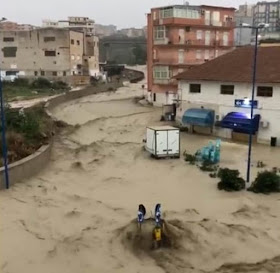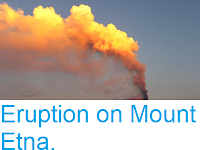Nine members of an extended family, including three children aged one, three and fifteen, have died after floodwaters swept through the house they were staying in at Casteldaccia in Palermo Province on the northwest of the Italian island of Sicily on Saturday 3 November 2018. Three generations of the same family were staying in the rented property for the All Souls Holiday long weekend, when it was hit by floodwaters from the River Milicia, which had burst its banks amid heavy rains. Only two members of the family survived the incident, away from the property walking the family dogs, and a fourth child who was outside when the floodwaters hit and was able to climb a tree.
The scene of a flood in Palermo District, Sicily, in which nine people died on Saturday 3 November 2018. Alessandro Fucarini/AFP/Getty Images.
The incident is now being investigated by local prosecutors, as the house, which was built without permission from local authorities, has been the subject of a demolition order since 2008 due to its proximity to the river, but had been allowed to stand while this decision was being appealed by the owners, something which the tenants were apparently unaware of.
Elsewhere on Palermo Province, a 44-year-old local councillor was killed when his car was struck by floodwaters from the San Leonardo River, another person is missing following this incident. In Agrigento Province on the southwest of the island a man and a woman are reported to have died in floodwaters from the Akragas River, while two people, one of them a German tourist, have died in flooding on the island of Sardinia.
Floodwaters in the town of Sciacca in Agrigento Province, Sicily, on Saturday 3 November 2018. Giornale di Sicilia.
These incidents come amid storms and flooding that have killed more than 20 people across Italy this week. Most storms form due to heating of air over the sea, in this case the Mediterranean. As
the air is heated the the air pressure drops and the air rises, causing
new air to rush in from outside the forming storm zone. If this zone is
sufficiently large, then it will be influenced by the Coriolis Effect,
which loosely speaking means the winds closer to the equator will be
faster than those further away, causing the storm to rotate, clockwise
in the northern hemisphere and anticlockwise in the southern hemisphere.
Whilst
the high winds associated these storms is extremely dangerous, the real
danger from such storms is often the flooding. Each millibar drop in
air pressure can lead to a 1 cm rise in sea level, and large storms can
be accompanied by storm surges several meters high. This tends to be
accompanied by high levels of rainfall, caused by water picked up by the
storm while still at sea, which can lead to flooding, swollen rivers
and landslides; which occur when waterlogged soils on hill slopes lose
their cohesion and slump downwards, over whatever happens to be in their
path.
See also...
Follow Sciency Thoughts on Facebook.








